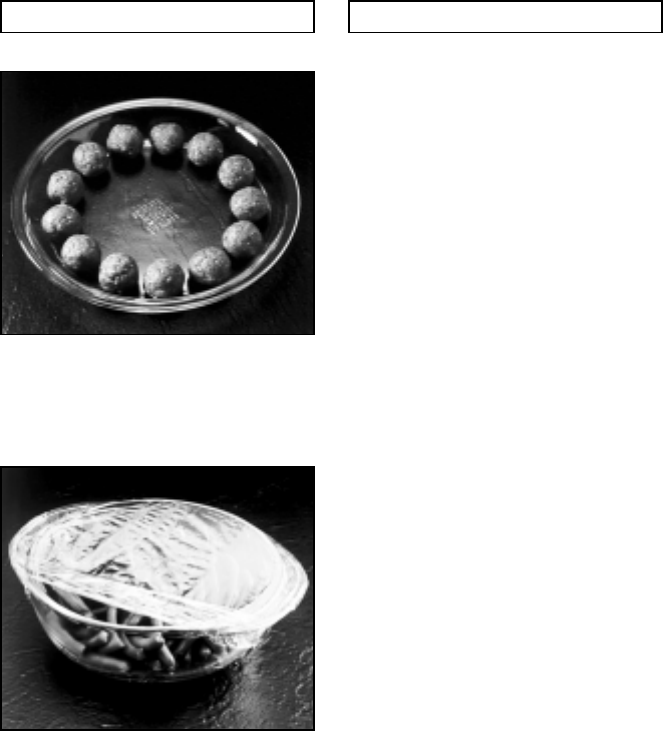
1514
Food Characteristics Cooking Techniques
Bone and Fat
Both bone and fat affect cooking. Bones may
cause irregular cooking. Meat next to the tips of
bones may overcook while meat positioned under
a large bone, such as a ham bone, may be
undercooked. Large amounts of fat absorb
microwave energy and the meat next to these
areas may overcook.
Density
Porous, airy foods such as breads, cakes or rolls
take less time to cook than heavy, dense foods
such as potatoes and roasts. When reheating
donuts or other foods with different centers be
very careful. Certain foods have centers made
with sugar, water or fat and these centers attract
microwaves (For ex., jelly donuts). When a jelly
donut is heated, the jelly can become extremely
hot while the exterior remains warm to the touch.
This could result in a burn if the food is not
allowed to cool properly in the center.
Quantity
Two potatoes take longer to cook than one pota-
to. As the quantity of the food increases so does
the cooking time. When cooking small amounts of
food such as one or two potatoes, do not leave
oven unattended. The moisture content in the
food may decrease and a fire could result.
Shape
Uniform sizes heat more evenly. The thin end of a
drumstick will cook more quickly than the meaty
end. To compensate for irregular shapes, place
thin parts toward the center of the dish and thick
pieces toward the edge.
Size
Thin pieces cook more quickly than thick pieces.
Starting Temperature
Foods that are room temperature take less time
to cook than if they are chilled or refrigerated or
frozen.
Piercing
Foods with skins or membranes must be pierced
scored or have a strip of skin peeled before cook-
ing to allow steam to escape. Pierce whole egg
yolks and whites, clams, oysters, chicken livers,
whole potatoes and whole vegetables. Whole
apples or new potatoes should have a 1-inch strip
of skin peeled before cooking. Score sausages
and frankfurters.
Browning
Foods will not have the same brown appearance
as conventionally cooked foods or those foods
which are cooked utilizing a browning feature.
Meats and poultry may be coated with browning
sauce, Worcestershire sauce, barbecue sauce or
shake-on browning sauce. To use, combine
browning sauce with melted butter or margarine;
brush on before cooking.
For quick breads or muffins, brown sugar can be
used in the recipe in place of granulated sugar, or
the surface can be sprinkled with dark spices
before baking.
Cooking Techniques Cooking Techniques
Shielding
Thin areas of meat and poultry cook more quickly
than meaty portions. To prevent overcooking,
these thin areas can be shielded with strips of
aluminum foil. Wooden toothpicks may be used to
hold the foil in place.
Timing
A range in cooking time is given in each recipe.
The time range compensates for the uncontrol-
lable differences in food shapes, starting temper-
ature and regional preferences. Always cook food
for the minimum cooking time given in a recipe
and check for doneness. If the food is under-
cooked, continue cooking. It is easier to add time
to an undercooked product. Once the food is
overcooked, nothing can be done.
Stirring
Stirring is usually necessary during microwave
cooking. We have noted when stirring is helpful,
using the words once, twice, frequently or occa-
sionally to describe the amount of stirring neces-
sary. Always bring the cooked outside edges
toward the center and the less cooked center por-
tions toward the outside of the dish.
Rearranging
Rearrange small items such as chicken pieces,
shrimp, hamburger patties or pork chops.
Rearrange pieces from the edge to the center
and pieces from the center to the edge of the
dish.
Turning
It is not possible to stir some foods to redistribute
the heat. At times, microwave energy will concen-
trate in one area of a food. To help insure even
cooking, these foods need to be turned. Turn
over large foods, such as roasts or turkeys,
halfway through cooking.
Stand Time
Most foods will continue to cook by conduction
after the microwave oven is turned off. In meat
cookery, the internal temperature will rise 5°F to
15°F (3°C to 8°C), if allowed to stand, tented with
foil, for 10 to 15 minutes. Casseroles and
vegetables need a shorter amount of standing
time, but this standing time is necessary to allow
foods to complete cooking to the center without
overcooking on the edges.
Testing Doneness
The same tests for doneness used in convention-
al cooking may be used for microwave cooking.
Meat is done when fork-tender or splits at fibers.
Chicken is done when juices are clear yellow and
drumstick moves freely. Fish is done when it
flakes and is opaque. Cake is done when a tooth-
pick or cake tester is inserted and comes out
clean. Candy is done when it reaches the proper
temperature for each stage of crystallization.
Spacing
Individual foods, such as baked potatoes, cup-
cakes and appetizers, will cook more evenly if
placed in the oven equal distances apart. When
possible, arrange foods in a circular pattern.
Covering
As with conventional cooking, moisture evapo-
rates during microwave cooking. Casserole lids or
plastic wrap are used for a tighter seal. When
using plastic wrap, vent the plastic wrap by fold-
ing back part of the plastic wrap from the edge of
the dish to allow steam to escape. Loosen or
remove plastic wrap as recipe directs for stand
time. When removing plastic wrap covers, as well
as any glass lids, be careful to remove them
away from you to avoid steam burns. Various
degrees of moisture retention are also obtained
by using wax paper or paper towels. However,
unless specified, a recipe is cooked covered.


















